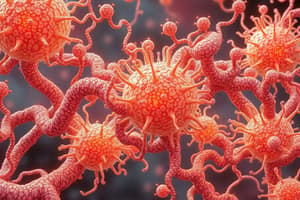Podcast
Questions and Answers
Which experiment demonstrated that cells arise only from pre-existing cells?
Which experiment demonstrated that cells arise only from pre-existing cells?
- Lazaro Spallanzani's experiment
- Francesco Redi's experiment
- John Needham's experiment
- Louis Pasteur's experiment (correct)
What does the second tenet of cell theory state?
What does the second tenet of cell theory state?
- Cells can spontaneously generate from inanimate matter.
- Cells are the smallest and most basic unit of structure and function. (correct)
- All organisms are composed of one or more cells.
- All diseases begin with a problem in cell function.
Which scientist proposed that all plants are composed of cells?
Which scientist proposed that all plants are composed of cells?
- Rudolf Virchow
- Louis Pasteur
- Theodore Schwann
- Mattias Schleiden (correct)
How did Lazaro Spallanzani's experiment build upon John Needham's findings?
How did Lazaro Spallanzani's experiment build upon John Needham's findings?
Which of the following statements is a misconception regarding cell theory?
Which of the following statements is a misconception regarding cell theory?
What is the primary role of the nucleolus in a cell?
What is the primary role of the nucleolus in a cell?
Which structure is primarily responsible for synthesizing lipids?
Which structure is primarily responsible for synthesizing lipids?
What is the function of the pores in the nuclear membrane?
What is the function of the pores in the nuclear membrane?
What distinguishes the rough endoplasmic reticulum from the smooth endoplasmic reticulum?
What distinguishes the rough endoplasmic reticulum from the smooth endoplasmic reticulum?
What is the role of the Golgi apparatus?
What is the role of the Golgi apparatus?
What best describes vesicles in a cell?
What best describes vesicles in a cell?
Which face of the Golgi apparatus is responsible for receiving materials?
Which face of the Golgi apparatus is responsible for receiving materials?
Which of the following statements about the cell nucleus is incorrect?
Which of the following statements about the cell nucleus is incorrect?
What is a defining characteristic of prokaryotic cells?
What is a defining characteristic of prokaryotic cells?
Which of the following is an example of a eukaryotic organism?
Which of the following is an example of a eukaryotic organism?
In prokaryotic cells, where is the genetic material primarily located?
In prokaryotic cells, where is the genetic material primarily located?
Which statement accurately distinguishes eukaryotic cells from prokaryotic cells?
Which statement accurately distinguishes eukaryotic cells from prokaryotic cells?
Which of the following statements is true regarding organelles?
Which of the following statements is true regarding organelles?
What is the role of epithelial cells in animals?
What is the role of epithelial cells in animals?
Which of the following is NOT a characteristic of eukaryotic cells?
Which of the following is NOT a characteristic of eukaryotic cells?
Which organelle is distinctly absent in prokaryotic cells?
Which organelle is distinctly absent in prokaryotic cells?
What happens during Prophase II?
What happens during Prophase II?
During which phase do chromosomes align at the cell equator?
During which phase do chromosomes align at the cell equator?
What is primarily happening in Anaphase II?
What is primarily happening in Anaphase II?
Which event does NOT occur during Telophase II?
Which event does NOT occur during Telophase II?
What initiates the formation of spindle fibers during Meiosis II?
What initiates the formation of spindle fibers during Meiosis II?
Which phase directly follows Prophase II?
Which phase directly follows Prophase II?
Which description is correct regarding the chromosomes during Meiosis II?
Which description is correct regarding the chromosomes during Meiosis II?
What occurs immediately after the chromosomes are pulled to opposite poles in Anaphase II?
What occurs immediately after the chromosomes are pulled to opposite poles in Anaphase II?
What is the primary function of vacuoles in plant cells?
What is the primary function of vacuoles in plant cells?
Which of the following structures primarily organizes microtubules in the cell?
Which of the following structures primarily organizes microtubules in the cell?
What is a characteristic feature of mitochondria?
What is a characteristic feature of mitochondria?
What role do lysosomes play in cellular function?
What role do lysosomes play in cellular function?
What is the function of peroxisomes?
What is the function of peroxisomes?
What is a key difference between cilia and flagella?
What is a key difference between cilia and flagella?
What do plastids primarily produce for plant cells?
What do plastids primarily produce for plant cells?
Which structures provide structural support and organization to the cell?
Which structures provide structural support and organization to the cell?
Which of the following is NOT a function of mitochondria?
Which of the following is NOT a function of mitochondria?
How do vacuoles differ in animal cells compared to plant cells?
How do vacuoles differ in animal cells compared to plant cells?
Study Notes
Cell Theory
- The cell theory states that all living organisms are composed of one or more cells, cells are the basic unit of structure and function in organisms, and that all cells arise from pre-existing cells.
- The cell theory was developed through a series of experiments, which challenged the idea of spontaneous generation, the theory that living organisms can arise from non-living matter.
- Key experiments that contributed to the development of the cell theory include Francesco Redi's experiment, John Needham's experiment, Lazaro Spallanzani's experiment, and Louis Pasteur's experiment.
- The cell theory was further developed by Theodore Schwann, who proposed that all animals are made up of cells, and Mattias Schleiden, who proposed that all plants are made up of cells.
- Rudolf Virchow later proposed that diseases start with problems in cells, further solidifying that cells came from previously existing cells.
Key Cell Organelles
- The nucleus contains DNA, which provides the instructions for the cell's activities.
- The nucleolus is a structure within the nucleus responsible for the production of proteins that code for cell characteristics.
- The endoplasmic reticulum (ER) is a network of membranes that plays a role in protein synthesis and lipid production. Rough ER is associated with protein synthesis, while smooth ER is associated with lipid synthesis.
- The Golgi apparatus modifies, sorts, and packages proteins. It has two sides: the cis face which receives proteins and the trans face which releases them.
- Vesicles are small membrane-bound sacs that enclose substances like proteins and lipids for transport.
- Vacuoles are larger, membrane-bound sacs that store water, nutrients, and other substances necessary for the cell's survival. Animal cells have numerous small vacuoles while plant cells have a single large central vacuole.
- Lysosomes contain enzymes that break down substances.
- Peroxisomes contain enzymes that break down hydrogen peroxide into water and oxygen.
- Mitochondria are responsible for producing energy for the cell in the form of ATP through cellular respiration. They have a double-membrane structure with folds called cristae.
- Plastids are found in plant cells and are responsible for producing energy for plant growth. They have their own DNA and ribosomes.
- Centrosomes and centrioles are primary microtubule organizing centers found in animal cells.
- Cilia and flagella are hair-like structures on the cell surface that help in movement. Cilia move fluids or propel the cell through fluids, while flagella propel the cell faster.
- The cytoskeleton is a network of protein filaments and tubules that provide structural support, shape, and organization to the cell.
Prokaryotic vs. Eukaryotic Cells
- Prokaryotic cells lack a distinct nucleus and membrane-bound organelles.
- Eukaryotic cells have a distinct nucleus and membrane-bound organelles.
- Prokaryotic cells have genetic material present in the nucleoid, which is not enclosed by a membrane. They may also have extrachromosomal DNA in the form of plasmids.
- Eukaryotic cells have their genetic material inside the nucleus.
- Prokaryotes do not have membrane-bound organelles, while eukaryotic cells have them.
- Examples of prokaryotic cells include *E.coli, Streptococcus pneumoniae, Salmonella enterica, and Staphylococcus aureus.
- Examples of eukaryotic cells include yeast, amoeba, fungi, animal cells, and plant cells.
Cell Types
- Epithelial cells are cells that line surfaces of organs and act as protective barriers. They have receptors for detection of environmental agents and play a role in tissue repair.
Cell Cycle
- The cell cycle is a series of events that take place in a cell leading to its division and duplication.
- The cell cycle involves two major phases, Interphase and the Mitotic (M) phase.
- Interphase is the period of cell growth and replication of cellular components. It is further divided into three stages:
- G1 phase (Growth 1): The cell increases in size.
- S phase (Synthesis): The cell replicates its DNA.
- G2 phase (Growth 2): The cell prepares for mitosis.
- Mitotic (M) phase is the period where the cell divides into two daughter cells. It is divided into:
- Mitosis: Division of the nucleus. This has four stages:
- Prophase: Condensation of chromosomes, nuclear membrane breaks down, spindle fibers form.
- Metaphase: Chromosomes align at the cell equator, spindle fibers attach to centromeres.
- Anaphase: Sister chromatids of each chromosome separate and move to opposite ends of the cell.
- Telophase: The chromosomes arrive at opposite poles, decondense, nuclear envelope reforms, cell division begins.
- Cytokinesis: Division of the cytoplasm resulting in two daughter cells.
- Mitosis: Division of the nucleus. This has four stages:
Meiosis
- Meiosis is a type of cell division that produces gametes (sperm and egg cells). It involves two rounds of division.
- Meiosis I:
- Prophase I: Chromosomes condense, homologous chromosomes pair up (synapsis), crossing over occurs.
- Crossing over results in the exchange of genetic material between chromosomes.
- Metaphase I: Homologous chromosome pairs align at the cell equator.
- Anaphase I: Homologous chromosomes separate and move to opposite poles.
- Telophase I: Chromosomes arrive at opposite poles and divide, resulting in two daughter cells.
- Prophase I: Chromosomes condense, homologous chromosomes pair up (synapsis), crossing over occurs.
- Meiosis II:
- Prophase II: Nuclear membrane breaks down, spindle fibers form, chromosomes condense.
- Metaphase II: Chromosomes align at the cell equator.
- Anaphase II: Sister chromatids separate and move to opposite poles.
- Telophase II: Chromatids arrive at opposite poles, decondense, nuclear envelope reforms, cell division begins.
- The result of meiosis is four daughter cells, each with half the number of chromosomes as the original cell.
Cell Modifications
- Different cell types have modifications in their structure and function. For example, epithelial cells have specialized structures for protection, absorption, and secretion.
- Cell modifications are often related to the cell's function. For instance, nerve cells have long axons and dendrites to conduct signals, while muscle cells have specialized proteins for contraction.
Studying That Suits You
Use AI to generate personalized quizzes and flashcards to suit your learning preferences.
Related Documents
Description
This quiz explores the foundational concepts of cell theory, detailing the experiments that led to its development and the significance of cell organelles. It highlights key scientists who contributed to our understanding of cells, including Schwann and Schleiden, and discusses the implications for diseases. Test your knowledge on how living organisms are structured at the cellular level.





